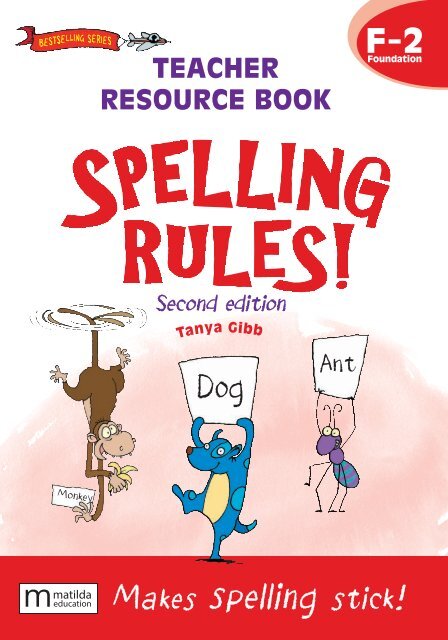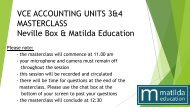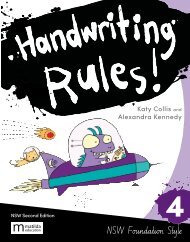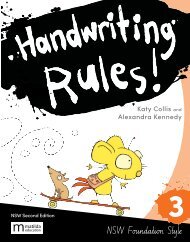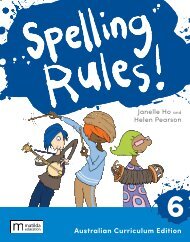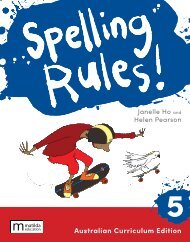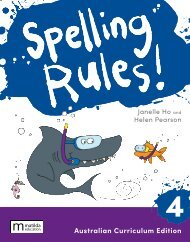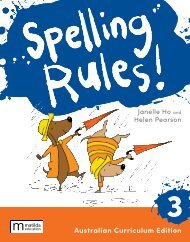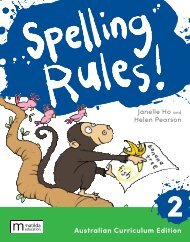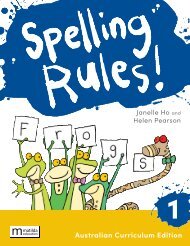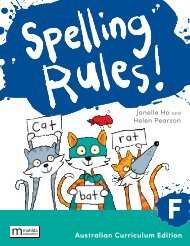Spelling Rules F-2 2e Teacher Resource Book sample/look inside
- No tags were found...
You also want an ePaper? Increase the reach of your titles
YUMPU automatically turns print PDFs into web optimized ePapers that Google loves.
BESTSELLI LING SERIES<br />
TEACHER<br />
RESOURCE BOOK<br />
F–2<br />
Foundation<br />
Second edition<br />
Tanya Gibb<br />
Dog<br />
Ant<br />
Monkey<br />
Makes<br />
spelling<br />
stick!
TEACHER<br />
RESOURCE BOOK<br />
Foundation–2<br />
Second edition<br />
Tanya Gibb
Dictionaries to support the<br />
<strong>Spelling</strong> <strong>Rules</strong>! program<br />
Ages 6–10<br />
Ages 10–15<br />
This edition published in 2021 by<br />
Matilda Education Australia, an imprint<br />
of Meanwhile Education Pty Ltd<br />
Level 1/274 Brunswick St<br />
Fitzroy, Victoria Australia 3065<br />
T: 1300 277 235<br />
E: customersupport@matildaed.com.au<br />
www.matildaeducation.com.au<br />
Copyright © Tanya Gibb/Macmillan Education Australia 2016<br />
All rights reserved.<br />
First edition published in 2016.<br />
Except under the conditions described in the Copyright Act 1968 of<br />
Australia and subsequent amendments, no part of this publication may be<br />
reproduced, stored in a retrieval system, or transmitted in any form or by<br />
any means, electronic, mechanical, photocopying, recording or otherwise,<br />
without the prior written permission of the copyright owner.<br />
Educational institutions copying any part of this book for educational<br />
purposes under the Act must be covered by a Copyright Agency<br />
Limited (CAL) licence for educational institutions and must have given<br />
a remuneration notice to CAL. Licence restrictions must be adhered to.<br />
Any copies must be photocopies only, and they must not be hired out or<br />
sold. For details of the CAL licence contact: Copyright Agency Limited,<br />
Level 11, 66 Goulburn Street, Sydney, NSW 2000.<br />
Telephone: (02) 9394 7600. Facsimile: (02) 9394 7601.<br />
Email: info@copyright.com.au<br />
Publisher: First edition Sharon Dalgleish<br />
Designers: Trish Hayes and Stephen Michael King<br />
Illustrator: Stephen Michael King<br />
Printed in by <br />
1 2 3 4 5 6 7 25 24 23 22 21 20<br />
2
Contents<br />
Introduction.......................................... 4<br />
Learning to Spell...................................... 5<br />
Why Do We Need to Learn to Spell? ............................. 5<br />
Why Is It Hard to Learn How to Spell?. . . . . . . . . . . . . . . . . . . . . . . . . . . . 5<br />
How Do Students Learn to Spell? ................................ 5<br />
Types of <strong>Spelling</strong> Knowledge ................................... 6<br />
Making <strong>Spelling</strong> Stick .......................................... 6<br />
<strong>Spelling</strong> Stages........................................ 7<br />
Pre-phonetic, early phonetic, phonetic,<br />
transitional and conventional stages<br />
Glossary of <strong>Spelling</strong> Terms............................. 14<br />
Developing a Whole-School <strong>Spelling</strong> Policy ............... 16<br />
How to Develop a Whole-School <strong>Spelling</strong> Policy ................... 16<br />
A Sample Whole-School <strong>Spelling</strong> Policy .......................... 17<br />
The <strong>Spelling</strong> Classroom for Foundation to Year 2 .......... 20<br />
How to Set Up the Classroom for <strong>Spelling</strong>. . . . . . . . . . . . . . . . . . . . . . . . 20<br />
Developing Auditory, Visual and Kinaesthetic Perception ............. 21<br />
Integrating <strong>Spelling</strong> into the Reading and Writing Program ........... 22<br />
Games to Develop <strong>Spelling</strong> .................................... 25<br />
Assessing <strong>Spelling</strong>.................................... 28<br />
Why and How Do We Assess <strong>Spelling</strong>? ........................... 28<br />
Diagnosing <strong>Spelling</strong> Errors ..................................... 30<br />
Catering for the Struggling Speller . .................... 34<br />
Catering for the More Able Speller...................... 36<br />
A Sequential <strong>Spelling</strong> Program ......................... 38<br />
Student <strong>Book</strong> Foundation. ..............................39<br />
Skills Taught ................................................ 40<br />
Scope and Sequence ......................................... 41<br />
Word Lists . . . . . . . . . . . . . . . . . . . . . . . . . . . . . . . . . . . . . . . . . . . . . . . . . 42<br />
Useful Strategies. . . . . . . . . . . . . . . . . . . . . . . . . . . . . . . . . . . . . . . . . . . . . 43<br />
Unit-by-Unit Activities to Enhance Learning ....................... 44<br />
Student <strong>Book</strong> 1 ........................................60<br />
Skills Taught ................................................ 61<br />
Scope and Sequence ......................................... 62<br />
Word Lists . . . . . . . . . . . . . . . . . . . . . . . . . . . . . . . . . . . . . . . . . . . . . . . . . 63<br />
Useful Strategies. . . . . . . . . . . . . . . . . . . . . . . . . . . . . . . . . . . . . . . . . . . . . 65<br />
Unit-by-Unit Activities to Enhance Learning ....................... 66<br />
Student <strong>Book</strong> 2 ........................................84<br />
Skills Taught ................................................ 85<br />
Scope and Sequence ......................................... 86<br />
Word Lists . . . . . . . . . . . . . . . . . . . . . . . . . . . . . . . . . . . . . . . . . . . . . . . . . 87<br />
Useful Strategies. . . . . . . . . . . . . . . . . . . . . . . . . . . . . . . . . . . . . . . . . . . . . 89<br />
Unit-by-Unit Activities to Enhance Learning ....................... 90<br />
Reproducibles 1–25.............................. 108–132<br />
Answers for Student <strong>Book</strong>s Foundation, 1 and 2.......... 133
Introduction<br />
<strong>Spelling</strong> <strong>Rules</strong>! is a bestselling series of seven student books and two <strong>Teacher</strong> <strong>Resource</strong><br />
<strong>Book</strong>s, which have been reproduced in a second edition. This second edition includes<br />
a disc in the <strong>Teacher</strong> <strong>Resource</strong> <strong>Book</strong>s, Scope and Sequence charts updated for the<br />
Australian Curriculum and reflection activities in student books 1–4 to allow students<br />
to assess their own progress.<br />
The <strong>Spelling</strong> <strong>Rules</strong>! program is based on sound learning theory and pedagogy, using<br />
strategies that embed spelling in the long-term memory. The program systematically<br />
develops phonological, visual, kinaesthetic, morphemic and etymological spelling<br />
knowledge so that students learn how to spell at the same time as they are learning<br />
the spelling of specific words.<br />
The <strong>Spelling</strong> <strong>Rules</strong>! student books and <strong>Teacher</strong> <strong>Resource</strong> <strong>Book</strong>s work together as<br />
a complete spelling program. They can also be used independently as stand-alone<br />
resources for student use or teacher reference.<br />
The <strong>Spelling</strong> <strong>Rules</strong>! program has been designed to provide spelling instruction that<br />
is systematic, purposeful and sequential. Each student book includes a scope and<br />
sequence chart and units of work for students to complete. Each unit focuses on one<br />
or more English language sounds or letter patterns. These sounds or letter patterns<br />
are featured in the word list for each unit.<br />
High frequency words are also included in the word lists. High frequency words are<br />
words that students are likely to encounter when reading, and that they are likely to<br />
need when expressing their own ideas in writing. It is useful for students to learn the<br />
spelling of high frequency words because automatic spelling recall helps increase their<br />
fluency when writing.<br />
Activities in the student books focus specifically on the words in the word lists<br />
and also on teaching spelling in the context of reading and writing. Many activities<br />
incorporate vocabulary development and understanding of grammatical patterns<br />
to assist students in creating their own effective written texts.<br />
It is recommended that students spend a small amount of time practising their spelling<br />
each day. Focusing on a few words at a time, and reinforcing these, has proven to be<br />
the best way to ensure students retain spelling knowledge. It is anticipated that each<br />
unit in the student books will be completed over the course of a school week, with<br />
the extra activities suggested in the <strong>Teacher</strong> <strong>Resource</strong> <strong>Book</strong> used to supplement and<br />
reinforce all aspects of the student books.<br />
4
Learning to Spell<br />
Why Do We Need to Learn to Spell?<br />
<strong>Spelling</strong> is a tool for writing, in making meaning, in communicating effectively and to assist in<br />
‘getting the message across’ to the reader. Writers need to spell consistently and according<br />
to the conventions of the language they are writing in so that their writing can be read by<br />
others. It is also useful as a reader to have an understanding of spelling, to help make sense of<br />
a written text, although you do not need to be a good speller to be a good reader.<br />
Why Is It Hard to Learn How to Spell?<br />
<strong>Spelling</strong> is a highly complex process. It involves selecting the correct pattern of letters to<br />
represent the sounds in speech. In English writing, this means learning 26 letters of the<br />
alphabet and combining them to represent approximately 40 speech sounds or phonemes<br />
– and there are over 600 combinations of letters to use to represent those 40 phonemes.<br />
No wonder spelling can be difficult! And no wonder it is important to explicitly teach<br />
students the system.<br />
Another aspect of English that has rendered its spelling more challenging is the fact that English<br />
has adopted many words from other languages, and the spelling of these adopted words usually<br />
reflects the spelling – but not always the pronunciation – of the original language. Yacht is an<br />
example. Understanding that this word was adopted from the Dutch jacht can help students<br />
understand why the spelling does not reflect the English pronunciation.<br />
Also, pronunciations have changed over time so that the spelling of some words no longer<br />
reflects their pronunciation. Knew and gnaw are examples: originally the k and the g were<br />
pronounced, and the spelling remains the same even though the pronunciation has changed.<br />
Homophones also add to the complexity of spelling in English. Homophones are words that<br />
sound the same but have different spellings and meanings, for example there, their and they’re.<br />
For some learners of English as a second language, there are certain sounds that are<br />
difficult to hear or difficult to pronounce. For example, for speakers of Spanish as a<br />
first language, /th/ in them can easily become /d/; Arabic speakers might have difficulty<br />
distinguishing between /p/ and /b/; and Japanese speakers might have difficulty distinguishing<br />
between /l/ and /r/.<br />
It’s important to stay aware of the special circumstances of all your students and be<br />
prepared to remedy any difficulties.<br />
How Do Students Learn to Spell?<br />
It is likely that you will encounter a minority of students who are natural spellers. These<br />
students will become quite proficient spellers without explicit teaching instruction.<br />
However, even these students will stumble over spelling an unknown word unless they<br />
have been given the knowledge to help them work out how to go about it.<br />
Students need to be taught how to spell. Providing them with books and writing opportunities<br />
is a part of the equation, but these strategies will not, in themselves, teach the majority<br />
of students to spell. The vast majority of students need formal, systematic and sequential<br />
instruction. They need to be taught how spelling works, as well as the strategies and<br />
knowledge they can use to become independent, confident spellers and spelling risk-takers.<br />
To make progress as spellers, students need opportunities to engage in writing every day. The<br />
more time students spend engaged in writing activities, the more opportunities they have to try<br />
out what they are learning.<br />
5
Types of <strong>Spelling</strong> Knowledge<br />
Learning to spell involves the following types of spelling knowledge:<br />
Phonological knowledge uses memory of how a word sounds, and<br />
of the patterns of sounds in words. It relates to students’ aural skills.<br />
Visual knowledge uses memory of how letters and words <strong>look</strong>, and<br />
of the visual patterns in words. It relates to students’ visual skills.<br />
Kinaesthetic knowledge uses the physical memory of the feeling when saying different sounds and<br />
words, and when writing the shapes of letters and words. It relates to tactile perceptual awareness.<br />
Morphemic knowledge involves an understanding of the meaning or function of words, or<br />
parts of words, and applying this knowledge to spelling. It involves thinking skills.<br />
Etymological knowledge involves an understanding of the origins and history of words and<br />
the effect these have on spelling patterns. Remembering and making analogies involves thinking skills.<br />
Making <strong>Spelling</strong> Stick<br />
According to current brain research theory, the brain and its functions can be likened to a computer.<br />
A computer’s hard drive can be compared to our long-term memory. That’s where we store information<br />
that we want to be able to retrieve at any time in the future for re-use. The human brain has a huge<br />
capacity for long-term storage.<br />
The RAM or useful working memory of a computer is finite. If we overload a computer or expect too<br />
much of it at any one time, it will freeze or send the message ‘not enough memory’. The working memory<br />
in a human brain is also finite. Students need opportunities to process new information and then store it<br />
in their long-term memories (internal hard drive) for future use. It helps students to be exposed to small<br />
amounts of new information at a time. To expect them to learn too much at one session is asking for that<br />
‘not enough memory’ message.<br />
Another useful computer analogy is that if we work on a computer but don’t save the files, they disappear.<br />
If new information in the brain’s working memory is not transferred to long-term memory, it will be<br />
lost. If we want student brains to recognise that spelling retention is important, then we need to present<br />
small amounts of spelling to them at any one time, and then give them time to reinforce, practise and<br />
consolidate this information so that it is saved in their long-term memories. Otherwise, their brains<br />
will do the equivalent of sending it all to the trash. Human brains sort out the trash from the useful<br />
knowledge that’s worth storing while we are asleep. This is why, as teachers, we sometimes feel that we<br />
are getting nowhere, having to re-teach the same information for weeks, with none of it seeming to sink<br />
into students’ brains. Repeated exposure to information in small doses and plenty of practice will ensure<br />
that the information (spelling knowledge) gets saved in students’ long-term memories.<br />
Our brains also establish links and pathways between old information and new information. A sequential<br />
spelling program that builds on previous learning makes learning to spell a more manageable task for<br />
students. Presenting information to be learned through auditory, kinaesthetic and visual experiences<br />
supports students’ differing learning styles, and multiple sensory experiences also assist in establishing<br />
these connections and building on knowledge.<br />
6<br />
The <strong>Spelling</strong> <strong>Rules</strong>! program is designed to ensure that students commit spelling knowledge to longterm<br />
memory. An acronym that can summarise the strategies that will help spelling move from working<br />
memory to long-term memory is SLLURP.<br />
Say the word carefully and slowly to yourself.<br />
Listen to how each part of the word sounds in sequence.<br />
Look at the patterns of letters in the word and the shape of the word.<br />
Understand rules, word meanings and word origins.<br />
Remember similar words you can already spell and relate this knowledge to any new word.<br />
Practise writing the word until it is firmly fixed in long-term memory. A useful sequence<br />
for students to use is ‘<strong>look</strong>, say, cover, write, check’.
<strong>Spelling</strong> Stages<br />
There are five stages of spelling that students progress through, at individual rates, in order<br />
to become successful spellers.<br />
Student <strong>Book</strong>s Foundation, 1 and 2 in this series focus on the first three stages, which are the<br />
pre-phonetic stage, the early phonetic stage and the phonetic stage.<br />
The five spelling stages are linear but at times a student may be operating in two stages at once.<br />
For example, a competent speller who usually operates in the conventional stage might become a<br />
phonetic speller when attempting to spell a word that is totally unfamiliar such as a mathematical<br />
or scientific term.<br />
The Pre-Phonetic Stage<br />
The pre-phonetic stage is when students first become aware of print. They might ask you to<br />
write a shopping list for them, or notice when you skip words in a story that they have heard<br />
before. They understand what print is for, but they do not yet understand how it works.<br />
The student might use invented letters as well as some copied and conventional letters and/or<br />
scribble. They will ‘read’ it aloud to you, because they understand the concept that writing can<br />
be read and that the message remains constant.<br />
Supporting the Learner<br />
• Ensure that students can hear individual words in a stream of speech by speaking<br />
slowly and clearly. When you read big books or class books, point out in the text<br />
where each word ends and the next word begins.<br />
• Explore with students the sounds in words. Show how words can be separated<br />
into individual sounds and how the sounds can then be rejoined.<br />
• Write with students, in front of students and for students as their scribe. Encourage<br />
students to write, scribble and experiment.<br />
• Teach the conventions of English print. Show students how print in English is read<br />
from left to right, a page is read from top to bottom, and a book from front to back.<br />
The child is becoming aware of print<br />
conventions and is drawing scribbles<br />
and pretend letters. This needs to be<br />
interpreted and ‘read’ by the child.<br />
The <strong>sample</strong> ‘reads’: Dear Aunty Helen.<br />
7
The Early Phonetic Stage<br />
In the early phonetic stage, students are starting to associate sounds with symbols and might<br />
recognise some letters in the environment, for example on shop signs or in their name.<br />
They might use consonants or single letters to represent words or sounds in their writing. They are<br />
developing their knowledge of letters. Students are starting to understand sound–letter relationships and<br />
to spell words with two letters, or words with three letters that follow the pattern consonant–vowel–<br />
consonant (CVC) such as ‘mum’. They might also have started to develop a list of high frequency words<br />
that they recognise from their reading and use in their writing, including their own name or the names<br />
of siblings or friends.<br />
Supporting the Learner<br />
• Reinforce students’ early understanding of sound–letter<br />
relationships, especially through using CVC patterns<br />
(mum, dad).<br />
• Sound out words with students.<br />
• Clap out the syllables in words or make up actions for the<br />
syllables in each child’s name. For example, ‘Waiyin’ could<br />
have two jumps.<br />
• Ask students to listen for initial and final sounds in words.<br />
• Provide lots of opportunities for students to engage in<br />
writing and encourage students to ‘have a go’ at spelling.<br />
The student understands that writing is meant to be read and that the message can be read consistently.<br />
The student is not able to recognise individual words in a stream of speech and therefore omits the gaps<br />
between words when writing. The student writes all the letters known in upper-case except for ‘li’, which<br />
forms part of her own name, ‘Ali’.<br />
The student relies on memory to ‘read’ the text This is Ali’s work.<br />
The student is associating symbols with sounds. The student has started the sentence string using an<br />
upper-case I and completed it with a full stop. The writing still contains a mixture of upper-case and<br />
lower-case letters.<br />
The sentence reads: I did cooking and we ate it.<br />
8
The Phonetic Stage<br />
In the phonetic stage, students represent words in a phonetic way. Their<br />
writing can often be read quite well by adults because it is logical and<br />
students show an understanding that they need to match letters for sounds.<br />
Students are starting to show awareness of spelling rules and some<br />
conventions of written language such as full stops.<br />
A vocabulary of high frequency words is being stored in the long-term<br />
memory and students are able to retrieve these words when required.<br />
Supporting the Learner<br />
• Explicitly teach letter–sound correspondences and provide opportunities<br />
for students to practise their newly acquired knowledge.<br />
• Help students remember spelling patterns by explicitly examining words<br />
that include the patterns and pointing out significant visual features as well<br />
as mnemonic clues.<br />
• Teach students how to examine the visual patterns and shapes of words.<br />
• Point out examples in student writing or class reading where sounds need<br />
combinations of letters to represent them, for example ‘shop’.<br />
• Support students in developing a core vocabulary of high frequency words<br />
and ensure you help them store the words in long-term memory.<br />
• Begin to teach students about prefixes and suffixes as required in<br />
their writing.<br />
• Teach students about word families.<br />
• Teach students about contractions, for example I’m, don’t.<br />
• Explicitly teach students strategies for working out the spelling of unfamiliar words. Articulate<br />
for them the strategies you would use. Say to students, ‘Let’s sound it out . . . Let’s write it and see if<br />
it <strong>look</strong>s right . . . Let’s think about other words that sound the same – do we know how they are spelt?’<br />
And so on. Thinking out loud like this as a model for students helps to reinforce what they can do<br />
when spelling an unfamiliar word.<br />
• Have students write specific texts such as letters, cards, shopping lists, stories and poems.<br />
• Introduce proofreading strategies.<br />
• Play spelling games or games derived from spelling practice, for example Scrabble ® , bingo, snap.<br />
High frequency words are correct (the and of). It is possible to read the student’s writing and the<br />
student is starting to form words — febywe is a phonetic attempt to spell February. (It is also possible<br />
the student is not pronouncing February in a way that will assist even phonetic spelling attempts.)<br />
The text reads: the 9th of February.<br />
9
The student’s writing is progressing, but is still phonetic. Words are seen as discrete units and are<br />
written separately. High frequency words are usually written correctly (on, I, to, the). There is the<br />
correct use of upper-case I, and the self-corrected use of upper-case to start the sentence. Less common<br />
words are spelt phonetically using some letters to represent many (sceltnetns for skeletons). The student<br />
is prepared to tackle quite complex vocabulary. Correct pronunciation and sounding out the word<br />
might have assisted the student when attempting to spell museum (moozem) and dinosaurs’ (dinsoos).<br />
The sentence reads: On a rainy day I went to the museum and I saw dinosaurs’ skeletons.<br />
The text is relatively easy to<br />
read and all words are written<br />
as discrete units. The student<br />
is spelling some high frequency<br />
words correctly (and, the, they,<br />
you, said), but not others (die for<br />
did, oov for of). The student is still<br />
approaching spelling phonetically,<br />
but the phonetic spelling is not<br />
completely regular. The student<br />
copied Once upon a time from<br />
the board, but did not correctly<br />
copy time. The student is not<br />
pronouncing mother correctly,<br />
and has misspelt it twice using<br />
muvh. The student is adding extra<br />
letters because he or she is<br />
stretching the words to sound<br />
them out, hence uiel for will.<br />
The text reads: Once upon a time<br />
lived eight koalas. The mother said<br />
you will go and get some bread<br />
so they did. The mother was very<br />
proud of them.<br />
10
The student is spelling high frequency words correctly (and, it, had), but is still approaching<br />
spelling phonetically. The text is easy to read: all words are written as discrete units and the<br />
phonetic spelling is fairly regular. The student has correctly copied Bearded Dragon from the<br />
board. The student does not use y for the short y sound at the end of the word prickly (prikule).<br />
The student is not pronouncing prickly correctly, having stretched the word to sound it out, and<br />
has added an extra vowel sound between k and l. The student has not learned the suffix ed for<br />
<strong>look</strong>ed (<strong>look</strong>t). The student is not pronouncing felt correctly, and has spelt it filt. The student does<br />
not recognise a sentence.<br />
The text reads: Logan had a bearded dragon. It felt prickly and it <strong>look</strong>ed scary.<br />
11
The Transitional Stage<br />
In the transitional stage, students become aware of factors other than phonics that they can bring to spelling,<br />
for example visual knowledge of the way words <strong>look</strong>; knowledge of particular spelling patterns, especially<br />
more common ones such as ing, ed, scr, ay; knowledge of spelling rules such as ‘change y to i before adding<br />
-ly’; and understanding of word families. They are able to use syllabification and morphemic knowledge.<br />
They are able to use analogy to work out how to spell words or parts of words. They might know<br />
how to spell day and fry and so spell Friday as Fryday.<br />
Students have developed a substantial core vocabulary of high frequency and subject-specific words.<br />
Supporting the Learner<br />
• Explicitly teach spelling patterns to students.<br />
• Build on student understanding of word families.<br />
• Extend students’ understanding of the use of morphemes and etymology to remember spelling patterns.<br />
• Encourage students to use visual knowledge to check spelling.<br />
• Further develop students’ list of high frequency words.<br />
• Encourage students to write, and ensure they have a variety of purposes for which to write.<br />
• Encourage students to read, and ensure they are exposed to a variety of texts.<br />
• Expect that students will proofread their own work.<br />
The student has committed to<br />
memory some high frequency<br />
words with common letter<br />
patterns: think, because, so, went.<br />
Errors are still made: frends.<br />
Words are spelt in different ways<br />
within the same piece of writing:<br />
shold and shod for should; school<br />
and shcool for school and preckul<br />
for preschool; and were and wear<br />
for wear. The more common<br />
word of a homophone pair has<br />
been used: wood for would and no<br />
for know.<br />
The text is easy to read.<br />
12
The Conventional Stage<br />
In the conventional stage, the speller knows the rules and conventions of English and understands<br />
the complex relationship between sound and letter representation. Students will often know when<br />
they cannot spell a word. Conventional spellers use a variety of strategies to work out how to spell<br />
unfamiliar words and to remember known words, including the use of external references such as<br />
dictionaries. They have a large number of learned words, including subject-specific vocabulary, that<br />
they can retrieve from their long-term memory.<br />
Supporting the Learner<br />
• Support students as they further develop their<br />
use of phonological, visual, kinaesthetic, etymological<br />
and morphemic knowledge to spell. For example,<br />
phonological: revise irregular or uncommon letter<br />
patterns; visual: ensure that students are exposed<br />
to and focus on visual patterns in words; kinaesthetic:<br />
writing and typing words for themselves to support<br />
physical memory of the shapes of letter patterns<br />
and words; etymological and morphemic: thinking<br />
about word origins, word families and connections<br />
between words supports the brain in storing<br />
spelling in long-term memory.<br />
• Expect students to have a comprehensive list of<br />
words that they are able to retrieve from their<br />
long-term memory to use in their writing.<br />
• Ensure that students are given opportunities to<br />
read and write more complex texts for a range<br />
of purposes.<br />
• Expect that students will proofread their written<br />
work with a high degree of accuracy, using<br />
external references when necessary.<br />
High frequency words are correctly spelt. The student is applying rules (for example, doubling the<br />
m in swim when adding -ing). The student has correctly used the upper-case for Thursday and an<br />
apostrophe to indicate an abbreviation in didn’t.<br />
13
Glossary of <strong>Spelling</strong> Terms<br />
Affix<br />
The general term for a prefix or suffix, i.e. a<br />
morpheme added to either the beginning or<br />
end of a base word.<br />
Analogy<br />
Equivalence or likeness. Recognising how to spell<br />
one word because of its similarity to another,<br />
e.g. sip and pip.<br />
Antonym<br />
A word or word group with a meaning opposite<br />
to that of another word or word group, e.g. full<br />
and empty.<br />
Auditory perception<br />
Ability to distinguish sounds.<br />
Base word<br />
The basic form of a word, e.g. help. Prefixes and<br />
suffixes are added to the base word to change<br />
the meaning, indicate tense, form the plural etc.,<br />
e.g. helped, helping, helpful etc.<br />
Blend<br />
A combination of two consonants in which each<br />
retains its distinctive sound, e.g. /br/ in bread,<br />
/cl/ in clasp.<br />
Compound word<br />
Two or more words joined together to produce<br />
a new word with a different meaning,<br />
e.g. wheel + chair wheelchair.<br />
Consonant<br />
All the letters of the alphabet that aren’t vowels.<br />
Contractions<br />
Formed when two words are combined and then<br />
a letter or letters are omitted, e.g. didn’t for did<br />
not, I’ll for I will. Apostrophes are used in place of<br />
the deleted letter or letters.<br />
Conventional speller<br />
Someone who understands the conventions of<br />
spelling and applies them consistently when spelling.<br />
Digraph<br />
A pair of letters that represent a single speech<br />
sound, e.g. ea in beat, sh in shop, ar in dark.<br />
Early phonetic speller<br />
Someone who is starting to associate sounds with<br />
symbols and might recognise some letters in print.<br />
Etymology<br />
The origin and history of a word. It can often assist<br />
in understanding the reason for a word’s spelling.<br />
Final sound<br />
The last sound heard in a word, e.g. /d/ in bread<br />
Grapheme<br />
The smallest unit of writing to represent a sound,<br />
e.g. t in tip, th in these, mb in thumb.<br />
High frequency words<br />
Words that are commonly used in texts and speech.<br />
Homographs<br />
Words of different origin and meaning that are<br />
spelt the same, e.g. live in I live at home and a live<br />
one; bear in polar bear and to bear a burden.<br />
Homophones<br />
Words that are pronounced the same but have<br />
different spellings and meanings, e.g. deer and dear.<br />
Initial sound<br />
The first sound heard in a word, e.g. /s/ in stop.<br />
Invented spelling<br />
<strong>Spelling</strong> made up when a child is first learning to<br />
write. Sometimes called temporary spelling.<br />
Letter–sound relationship<br />
The way a sound is represented in writing.<br />
Long-term memory<br />
Where information is stored for later retrieval.<br />
Medial sound<br />
A sound that occurs within a word or syllable<br />
that is neither initial nor final.<br />
Minimal pairs<br />
Two words that differ by only one phoneme,<br />
e.g. hot/hat, get/pet.<br />
Mnemonic<br />
A memory cue, e.g. The principal of a school is my pal.<br />
Morpheme<br />
The smallest grammatical unit of language that has<br />
meaning. It can be a word, e.g. sit or by, or an element<br />
of a word, like mis- in mistake or -ing in singing.<br />
Morphology<br />
The study of word formation in a language by<br />
analysing word parts and word derivation.<br />
Onset and rime<br />
The beginning part or sound of the word is<br />
the onset and the rest of the word is the rime,<br />
e.g. m–atch. The breaking of words into beginnings<br />
and endings.<br />
14
Peer assessment<br />
Assessment undertaken by peers.<br />
Phoneme<br />
The smallest unit of sound in a language.<br />
Phonemic awareness<br />
Ability to recognise that words are made up of<br />
individual sounds (phonemes) and use letter–<br />
sound correspondences to read and spell<br />
words. (Sometimes used interchangeably with<br />
phonological awareness.)<br />
Phonetic speller<br />
A speller who represents words in a phonetic way.<br />
Phonological awareness<br />
Ability to recognise larger units of sound in<br />
addition to phonemes, e.g. syllables, onset and<br />
rime. Enables students to recognise and generate<br />
rhyming words, count syllables, and separate the<br />
beginning and ending of words. (Sometimes used<br />
interchangeably with phonemic awareness.)<br />
Phonology<br />
The sound system of language.<br />
Prefix<br />
An affix attached to the beginning of a base word<br />
to change the meaning, e.g. the prefix un- + base<br />
word like unlike.<br />
Pre-phonetic speller<br />
A speller who is just becoming aware of print.<br />
They might use invented letters as well as some<br />
copied and conventional letters and/or scribble.<br />
Pronunciation<br />
The act of producing speech sounds.<br />
Proofreading<br />
Checking a written text for correct spelling and<br />
other conventions of writing such as punctuation<br />
and grammar.<br />
Root word<br />
See Base word.<br />
Sight word<br />
A common word that often cannot be sounded<br />
out and that needs to be memorised, e.g. the,<br />
said, come.<br />
Silent letter<br />
A letter that does not represent a sound,<br />
e.g. w in wrestle, k in knight, l in folk.<br />
Suffix<br />
An affix attached to the end of a base word to<br />
change the meaning, e.g. the suffix -ly + base word<br />
like likely.<br />
Syllable<br />
A unit of sound within a word, e.g. to-mor-row.<br />
A syllable must contain a vowel or the letter y<br />
when it is acting as a vowel. Syllables usually start<br />
with a consonant: Sa-tur-day. Double consonants<br />
are usually split down the middle: hap-py. A word<br />
consisting of one syllable is monosyllabic. A word<br />
consisting of two or more syllables is multisyllabic<br />
or polysyllabic.<br />
Synonyms<br />
Words that have the same<br />
or similar meaning, e.g. throw and toss.<br />
Tense<br />
The form of the verb that shows time. Auxiliary<br />
verbs and/or suffixes attached to the end of the<br />
base form of the verb are used to show when an<br />
action happens, e.g. She plays. She is playing. (both<br />
are present tense) She played. (past tense) She<br />
will play. (future tense)<br />
Transitional speller<br />
A speller who is starting to use knowledge of<br />
particular spelling patterns, spelling rules, word<br />
families, syllabification and morphemes as well<br />
as phonological knowledge to spell words.<br />
Upper-case and lower-case letters<br />
Two forms of the letters of the alphabet. Uppercase<br />
letters are used to indicate the beginning of<br />
a sentence or the initial letter of a proper noun.<br />
Visual perception<br />
Ability to distinguish between shapes, objects<br />
and patterns by using the sense of sight.<br />
Vowels<br />
The letters a, e, i, o and u. The letter y is a semivowel,<br />
as it is a consonant that sometimes<br />
represents a vowel sound.<br />
15
Developing a Whole-School <strong>Spelling</strong> Policy<br />
A consistent approach to the teaching and learning<br />
of spelling throughout the school will benefit<br />
students, their families and staff. An important first<br />
step in implementing a whole-school approach to<br />
spelling is to develop a spelling policy.<br />
How to Develop<br />
a Whole-School <strong>Spelling</strong> Policy<br />
To begin with, staff members or a small<br />
subcommittee of staff members can meet to<br />
discuss how spelling is currently taught, what the<br />
school community (including families) expects<br />
regarding the teaching and assessing of spelling, what<br />
expectations there are of student achievement, and<br />
how government testing results and government<br />
benchmarks affect spelling in the school.<br />
A written survey for all staff members or by grades<br />
or year groups will elicit the sort of information<br />
required by the <strong>Spelling</strong> Committee. Ask questions<br />
such as: How do you currently teach spelling?<br />
Are you confident that the approach you use is<br />
working? For all students? For the majority of<br />
students? Which students are not benefiting from<br />
the school’s current approach to spelling? What<br />
is best about the school’s current approach?<br />
What concerns do you have about spelling in your<br />
classroom and across the school? What would<br />
you like to see happen regarding spelling across<br />
the whole school? What support would you like in<br />
order to implement a whole-school approach?<br />
Schools might also find it useful to gain the<br />
support of families at this stage. If a whole-school<br />
approach is to be implemented then the support<br />
of families in policy input and purchasing of<br />
resources, as classroom volunteers and at-home<br />
spelling partners, will be necessary as well as<br />
appreciated. The <strong>Spelling</strong> Committee could devise<br />
a questionnaire for families so that the views of<br />
parents and caregivers are taken into account when<br />
formulating the school’s spelling policy.<br />
What Constitutes a Whole-School<br />
Policy?<br />
On pages 17–19 you’ll find a <strong>sample</strong> policy to use<br />
as a starting point. Adapt it to suit your school’s<br />
needs. It contains the following sections:<br />
Philosophical Statement and Rationale<br />
Why is a whole-school program needed? What<br />
does the school value and believe about spelling?<br />
What particular learners is the school made up of<br />
(e.g. Indigenous, ESL, students with special needs)?<br />
Aim/s Clearly articulate the overall aim/s of a<br />
whole-school approach to spelling.<br />
Objectives Make broad statements of the values<br />
and attitudes, skills and knowledge that are promoted<br />
by the school’s policy.<br />
Curriculum Links or Standards These can be<br />
found in the Australian Curriculum and will be<br />
available in each state’s syllabus document.<br />
Student Assessment Outline the ways of<br />
collecting, recording and using assessment<br />
information in the school.<br />
Teaching Implications Cover the time frame for<br />
policy implementation (including factors such as the<br />
funding and purchasing of resources, teacher inservice<br />
training, training requirements of volunteers,<br />
staff meetings, team meetings and so forth) as well as:<br />
• how spelling will be taught in each year group and<br />
to the range of learners in the school, including<br />
the possibility of subject-accelerated progression<br />
in the area of spelling for gifted spellers<br />
• how and when students will be assessed and how<br />
the assessment information will be reported to<br />
families<br />
• the role of families in supporting the development<br />
of their child’s spelling as well as each student’s<br />
role and responsibilities.<br />
Support Material/<strong>Resource</strong>s Which resources<br />
will be used/purchased? Who will be responsible?<br />
Will the school purchase a commercially available<br />
whole-school program such as <strong>Spelling</strong> <strong>Rules</strong>!?<br />
Evaluation How will the policy be evaluated and<br />
revised, by whom and in what time frame?<br />
16
A Sample Whole-School <strong>Spelling</strong> Policy<br />
Scholarsville School<br />
Scholarsville<br />
School<br />
Whole-School<br />
<strong>Spelling</strong> Policy<br />
Philosophy<br />
The staff and families at Scholarsville School believe that learning how to spell correctly is a<br />
valuable tool for reading and writing and as such is useful across the entire school curriculum.<br />
We recognise that:<br />
• not all students will be natural spellers and that some students will struggle to attain and<br />
retain spelling knowledge<br />
• learning to spell is a complex task involving phonological, visual, kinaesthetic, morphemic<br />
and etymological knowledge and that individual students will rely to a different extent on<br />
each area of spelling knowledge<br />
• the vast majority of students need formal, systematic and sequential instruction about<br />
the way spelling works, as well as the strategies they can use and the knowledge they<br />
can develop to become independent, confident spellers and spelling risk-takers<br />
• all students need support in spelling, including struggling spellers, gifted spellers, students<br />
for whom English is a second language, and Aboriginal and Torres Strait Islander students<br />
• the working memory of a human brain is finite. Students need to be exposed to small<br />
amounts of new spelling information at any one time. They then need opportunities to<br />
practise and consolidate this new information so that it is stored in their long-term<br />
memories for future use.<br />
Rationale<br />
The enrolment at Scholarsville School includes 35% of students who are from non-Englishspeaking<br />
backgrounds. These students, as well as our students with English home language<br />
backgrounds, need a coherent, systematic teaching approach to spelling so that they develop<br />
the knowledge and skills to support effective written communication in English.<br />
Aim<br />
The aim of the whole-school spelling policy is to provide all students with systematic and<br />
sequential instruction in English spelling so that they develop positive attitudes to spelling,<br />
learn strategies to support their spelling learning and experience success in spelling.<br />
Objectives<br />
1. Students will value correct spelling and develop confidence<br />
in themselves as learners of spelling.<br />
2. Students will develop phonological, visual, kinaesthetic,<br />
morphemic and etymological spelling knowledge.<br />
3. Students will develop skills and strategies to help them<br />
remember spelling and tackle new words.<br />
17
18<br />
Curriculum Links<br />
See Australian Curriculum, English.<br />
In their Foundation year of schooling,<br />
students will:<br />
• develop positive attitudes about spelling and<br />
attempting to spell<br />
• recognise the different sounds in English and<br />
isolate sounds (phonemes) in words<br />
• name all lower- and upper-case letters and<br />
recognise the most common sound represented<br />
by each letter<br />
• recognise rhyme, alliteration, onset and rime, and<br />
syllables, and use these to spell words<br />
• recognise and write some high frequency words<br />
• learn to spell consonant-vowel-consonant (CVC)<br />
patterns using short vowel sounds, moving on to<br />
CCVC (like ship) and CVCC words (like hill),<br />
still using short vowel sounds<br />
• begin to develop the skill of proofreading for<br />
correct spelling.<br />
In Year 1, students will:<br />
• build on the skills and knowledge developed in<br />
the first year of schooling<br />
• make new words by adding, deleting or<br />
substituting letters<br />
• spell single-syllable words with short vowels,<br />
common long vowels, some consonant blends<br />
and consonant digraphs<br />
• understand how a letter can represent more than<br />
one sound<br />
• spell some two-syllable words<br />
• learn how to use mnemonics and analogy to<br />
attempt to spell new words<br />
• develop further understanding of word families<br />
and rhyming words<br />
• recognise and write some high frequency words<br />
• learn some spelling rules<br />
• begin to learn how to proofread<br />
• develop an understanding of alphabetical order<br />
and dictionary use.<br />
In Year 2, students will:<br />
• build on the letter patterns introduced in the first<br />
two years of schooling by learning about other<br />
digraphs and blends, irregular plurals, and silent letters<br />
• understand that a sound can be represented by<br />
different combinations of letters<br />
• read and write an expanding range of high<br />
frequency words<br />
• learn to use a variety of strategies to work out<br />
spelling: visual knowledge, morphemic and<br />
etymological knowledge, analogy, mnemonics<br />
• learn some spelling rules and conventions<br />
• learn about prefixes, suffixes, verb tense and<br />
contractions, and develop an understanding of<br />
how words are built upon a base word/how<br />
word families are formed<br />
• explore and build compound words.<br />
In Year 3, students will:<br />
• build on the skills and knowledge learned in<br />
the previous years of schooling with emphasis<br />
on the use of etymological knowledge, suffixes,<br />
prefixes, homophones, medial double consonants,<br />
apostrophes, capitalisation and spelling rules; write<br />
more complex texts for varying purposes and<br />
audiences; and develop an expanded vocabulary.<br />
In Year 4, students will:<br />
• build on the skills and knowledge learned in the<br />
previous years of schooling, with emphasis on<br />
spelling strategies needed to tackle unknown words,<br />
common prefixes and suffixes, word endings (such<br />
as f, ff, ph and gh), words adopted by English from<br />
other languages, abbreviations, more complex<br />
spelling rules, homophones, proofreading and<br />
subject-specific words.<br />
In Year 5, students will:<br />
• build on the skills and knowledge learned in the<br />
previous years of schooling; learn more about<br />
synonyms and antonyms; explore etymology,<br />
especially words with Latin, French and Greek<br />
roots; learn about acronyms, blends and eponyms;<br />
and explore subject-specific words.<br />
In Year 6, students will:<br />
• build on the skills and knowledge learned in the<br />
previous years of schooling, as well as reviewing<br />
all spelling rules and conventions; conduct a more<br />
detailed etymological and morphological study<br />
of words; review all affixes, words with difficult<br />
or irregular spelling patterns, homophones and<br />
homographs; explore subject-specific words; and<br />
use proofreading as an automatic process.
Student Assessment<br />
Student spelling achievement will be assessed weekly in each class, by class teachers, using a<br />
combination of students’ writing <strong>sample</strong>s, dictation tests and tests of the spelling lists covered<br />
in the <strong>Spelling</strong> <strong>Rules</strong>! program.<br />
Information about students’ spelling achievement will be recorded and this information will<br />
be provided to families informally, as the need arises, and formally, in response to requests<br />
from families or as determined by the teacher.<br />
Families will be provided with half-yearly and yearly written reports that outline spelling<br />
progress and development.<br />
Teaching Implications<br />
The school will implement this policy commencing Term 1.<br />
Each class will spend 15 minutes per day on explicit spelling instruction. <strong>Spelling</strong> instruction<br />
will also be integrated across all areas of learning. <strong>Spelling</strong> instruction will be supported<br />
by the classroom expectation that all students will engage in writing, daily, for a variety of<br />
purposes and audiences, and that this writing will be context based.<br />
<strong>Spelling</strong> instruction will be part of each day’s program as well as occurring spontaneously<br />
during the course of any activity that provides a teaching opportunity for spelling.<br />
Support Material/<strong>Resource</strong>s<br />
<strong>Spelling</strong> <strong>Rules</strong>! resources will be purchased for each student and class teacher during Term 4<br />
of the year before use. <strong>Teacher</strong>s will familiarise themselves with the program.<br />
In preparation for implementation of this policy, year-group meetings will be held on the<br />
first Mondays in October, November and December.<br />
Whole-staff training and professional development opportunities in spelling will be organised.<br />
Evaluation<br />
Evaluation of the policy and policy review will commence in October. Year-group meetings<br />
will be held on the first Mondays in October, November and December. Year groups will<br />
provide written feedback to the <strong>Spelling</strong> Committee about the impact of this policy on<br />
students and staff.<br />
The <strong>Spelling</strong> Committee will compile a written report for the school community on<br />
the progress of policy implementation, and make further recommendations to school<br />
management regarding teacher training, resources (personnel and equipment) and so on.<br />
Scholarsville<br />
School<br />
19
The <strong>Spelling</strong> Classroom for Foundation to Year 2<br />
How to Set Up the Classroom<br />
for <strong>Spelling</strong><br />
A spelling classroom for Foundation to Year 2<br />
will feature a selection of texts on display or<br />
readily accessible to students and equipment<br />
for experimenting with words and spelling. This<br />
equipment might be part of a spelling learning centre,<br />
established in one area of the classroom. It is also<br />
important that classroom management practices<br />
support students’ acquisition of spelling knowledge.<br />
20<br />
Texts on Display or Readily Accessible<br />
to Students<br />
These can include:<br />
• lists of useful words: names of students, topic<br />
words, high frequency words, word families, days<br />
of the week, months, a weather chart with words<br />
to attach for hot, windy, cloudy, rainy and so on<br />
• lists of stories read, poems learned, songs known<br />
• a class timetable<br />
• class rules constructed with student input: Walk<br />
<strong>inside</strong>, Use <strong>inside</strong> voices, Look after property, Put<br />
things away, Listen to your friends<br />
• signs and labels on all items and art work,<br />
constructed with student input, e.g. art cupboard,<br />
teacher’s desk, Goldie the Goldfish<br />
• examples of student texts<br />
• student stories and other texts that have been<br />
handwritten by you or another adult, or published<br />
on a computer<br />
• class books created jointly with the students<br />
(and opportunities for these to be borrowed by<br />
students to share with their families at home)<br />
• attractively presented and interesting reading<br />
materials, both literary and factual<br />
• dictionaries, word books, student spelling books,<br />
personal word lists, ‘have a go’ books.<br />
A <strong>Spelling</strong> Learning Centre<br />
Establish a spelling learning centre in your<br />
classroom for interested students, students who<br />
need extra spelling practice, or able spellers<br />
wanting more challenges. Games and activities<br />
could be for individual students, or students could<br />
be allowed to work in pairs or groups. The spelling<br />
centre could also be used when parent helpers and<br />
volunteers are available (or ‘buddies’ from older<br />
classes, if your school supports this practice).<br />
The spelling learning centre could include<br />
equipment such as:<br />
• task cards in a box, with word searches, tongue<br />
twister challenges, crossword puzzles<br />
• spelling games – Scrabble ® , Boggle ® , bingo,<br />
teacher-created games and resources<br />
• assorted writing materials: whiteboards, paper,<br />
cardboard, marker pens, felt pens, pencils, chalk,<br />
charcoal, crayons<br />
• magnet letters, letter tiles, letter cards, alphabet<br />
charts<br />
• play dough for making letters, and to improve<br />
hand strength and therefore fine motor control<br />
• a sand trough for writing words and letter shapes<br />
• magazines, scissors and glue<br />
• computers and tablets<br />
• audio recordings of poems, stories, chants and<br />
recorded sounds<br />
• percussion instruments to repeat sequences of<br />
sounds or rhythm patterns, or to create beats for<br />
the syllables in words.
Classroom Management Practices that<br />
Support <strong>Spelling</strong> Development<br />
To support spelling development:<br />
• allow time for students to write and spell every day<br />
• encourage reference to written language in the<br />
classroom during the week, and allow time to<br />
revisit and re-read the written texts and to point<br />
out aspects of spelling<br />
• provide specific lists of spelling words for<br />
students to learn. These lists need to be based<br />
on letter patterns or sounds and provide a<br />
clear scope and sequence of spelling skills. The<br />
lists should also allow for the addition of high<br />
frequency words and words from students’<br />
own writing<br />
• encourage students to refer to a wall chart that lists<br />
steps they can follow in working out how to spell a<br />
word, for example Reproducible 1, blown up to<br />
A3 size<br />
• include parents and other volunteers, and/or<br />
peer tutors<br />
• use varied grouping arrangements (ability<br />
grouping, mixed-ability grouping, pairs, small<br />
groups, mixed-age groups).<br />
Developing Auditory, Visual<br />
and Kinaesthetic Perception<br />
It is important to develop auditory, visual and<br />
kinaesthetic perception in young children, because<br />
these form the basis for the development of<br />
phonological, visual and kinaesthetic spelling<br />
knowledge, among other things.<br />
You will find that during early spelling development<br />
students will more readily hear the sound at the<br />
beginning of a word. They are usually next able to<br />
identify the final sound, and then lastly the sounds<br />
in the middle of a word.<br />
Visual Perception<br />
Visual perception can be developed using the<br />
following activities:<br />
• learning to really <strong>look</strong> at letters, and combinations<br />
of letters<br />
• distinguishing between letters in written activities<br />
(e.g. by colouring every t)<br />
• <strong>look</strong>ing at the shapes and lengths of words<br />
(e.g. the different shapes of dog, elephant)<br />
• using consistent letter shapes and neat writing so<br />
that letters and words are easily recognisable<br />
• taking a mental picture of a word, and writing it in<br />
the air with eyes closed<br />
• using ‘<strong>look</strong>, say, cover, write, check’<br />
• doing any activity that requires students to<br />
use their eyes to problem-solve: jigsaw puzzles,<br />
categorising words by shape, matching and sorting<br />
words into word families, sequencing objects by<br />
colour, shape, size.<br />
Auditory Perception<br />
Auditory perception can be developed using the<br />
following activities:<br />
• recognising and labelling sounds<br />
• repeating a sequence of sounds<br />
• learning to distinguish beginning, final and middle<br />
sounds in words<br />
• breaking a word into component sounds or syllables<br />
• clapping out a rhythm<br />
• clapping the syllables in words<br />
• recognising rhyming words, alliteration and<br />
assonance, onset and rime<br />
• using ‘<strong>look</strong>, say, cover, write, check’.<br />
21


